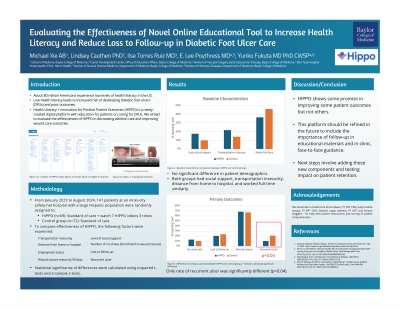Clinical Research
(CR-083) Evaluating the Effectiveness of an Innovative Health Literacy Educational Platform to Improve Patient Retention in Diabetic Foot Ulcer Care
Friday, May 2, 2025
7:45 PM - 8:45 PM East Coast USA Time

Lindsey Cauthen, PhD; Yuriko Fukuta, MD, PhD, CWSP
Introduction: Approximately 8,000,000 people experience low levels of health literacy in the US.1,2 Previous studies have shown that low health literacy leads to increased risk of developing diabetic foot ulcers (DFUs).3 Health Literacy + Innovation for Positive Patient Outcomes (HIPPO) is a preexisting digital app that provides multimedia educational resources for low health literacy patients; however, its efficacy has never been studied. Thus, we aimed to examine HIPPO’s effect on patient retention among DFU patients.
Methods: From January 2023 to August 2024, an open-label trial was performed at a wound clinic in a teaching hospital that serves a large, underserved population including immigrants. Newly referred adult participants with DFUs were enrolled and randomly assigned to either HIPPO or control group after enrollment. HIPPO consisted of 7 multilingual instructional videos and graphical illustrations. In the HIPPO group, participants were asked to watch the videos during 3 office visits besides standard of care (SOC). The control group received only SOC. Initial wound assessment, wound healing status in 3 months, patient compliance, and appointment attendance were recorded for both patient groups. We also reviewed the factors that can affect patient retention. Statistical analysis involved unpaired t-tests and 2-sample z-tests.
Results: Sixty-nine participants were assigned to HIPPO and 72 to the control group. Differences in 3-month wound healing rate (HIPPO 68% vs. control 67%), compliance in wound dressing (HIPPO 90.6% vs. control 97.2%), no-show rate (HIPPO 13% vs. control 10%), and attrition rate (HIPPO 20.2% vs. control 23.6%) were not statistically significant (p=0.97, 0.336, 0.5, 0.97). However, HIPPO group had a statistically significant lower percentage of wound reopening (10% vs. control 21%, p=0.04). Between the two groups, differences in percentage of social support, transportation insecurity, full-time employment, distance to hospital, age, and English as primary language were also not statistically significant (p=0.09, 0.11, 0.12, 0.84, 0.45, 0.18).
Discussion: HIPPO shows some promise in improving some patient outcomes but not others. This platform should be refined in the future to include the importance of follow-up in educational materials and in-clinic, face-to-face guidance. Next steps involve adding these new components and testing impact on patient retention.
Methods: From January 2023 to August 2024, an open-label trial was performed at a wound clinic in a teaching hospital that serves a large, underserved population including immigrants. Newly referred adult participants with DFUs were enrolled and randomly assigned to either HIPPO or control group after enrollment. HIPPO consisted of 7 multilingual instructional videos and graphical illustrations. In the HIPPO group, participants were asked to watch the videos during 3 office visits besides standard of care (SOC). The control group received only SOC. Initial wound assessment, wound healing status in 3 months, patient compliance, and appointment attendance were recorded for both patient groups. We also reviewed the factors that can affect patient retention. Statistical analysis involved unpaired t-tests and 2-sample z-tests.
Results: Sixty-nine participants were assigned to HIPPO and 72 to the control group. Differences in 3-month wound healing rate (HIPPO 68% vs. control 67%), compliance in wound dressing (HIPPO 90.6% vs. control 97.2%), no-show rate (HIPPO 13% vs. control 10%), and attrition rate (HIPPO 20.2% vs. control 23.6%) were not statistically significant (p=0.97, 0.336, 0.5, 0.97). However, HIPPO group had a statistically significant lower percentage of wound reopening (10% vs. control 21%, p=0.04). Between the two groups, differences in percentage of social support, transportation insecurity, full-time employment, distance to hospital, age, and English as primary language were also not statistically significant (p=0.09, 0.11, 0.12, 0.84, 0.45, 0.18).
Discussion: HIPPO shows some promise in improving some patient outcomes but not others. This platform should be refined in the future to include the importance of follow-up in educational materials and in-clinic, face-to-face guidance. Next steps involve adding these new components and testing impact on patient retention.

.jpg)